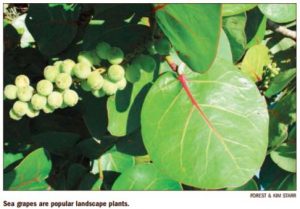Visitors to the Florida Keys see them as robust shrubs and trees with large, round, fan-like leaves as big as your hand. They’re often seen in road medians, shopping center landscapes and impeccably landscaped yards. To the locals, they’re useful hedges and screens in yards, as well as important in preventing sand dune erosion. Sea grapes are those beautiful, native and wonderfully adaptive landscape plants seen nearly everywhere in South Florida. The most distinctive feature of the sea grape is the large green leaf that can be big enough to use as a plate.
 In the summertime, the fruit clusters start to appear, adding another stunning feature to the plant. The fruit of sea grapes start as racemes, 6- to 10-inch-long clusters of small white flowers. These eventually transform into long clusters of small, egg-shaped, green globes. As they mature in the late summer and fall, they turn from green to red to purple. Floridians often reminisce about childhood days of shaking ripe grapes from the branches and gorging themselves. Miami Herald columnist Linda Cicero recalls they taste “like an old Muscadine grape married a plum.” They ripen intermittently, however green grapes won’t ripen once picked. The tried-and-true method of harvesting is to place a sheet or towel beneath the shrub and shake the branches for the ripe fruits to fall. Another method is to place a grocery bag completely over a long strand of grapes and shake until all the ripe ones fall in.
In the summertime, the fruit clusters start to appear, adding another stunning feature to the plant. The fruit of sea grapes start as racemes, 6- to 10-inch-long clusters of small white flowers. These eventually transform into long clusters of small, egg-shaped, green globes. As they mature in the late summer and fall, they turn from green to red to purple. Floridians often reminisce about childhood days of shaking ripe grapes from the branches and gorging themselves. Miami Herald columnist Linda Cicero recalls they taste “like an old Muscadine grape married a plum.” They ripen intermittently, however green grapes won’t ripen once picked. The tried-and-true method of harvesting is to place a sheet or towel beneath the shrub and shake the branches for the ripe fruits to fall. Another method is to place a grocery bag completely over a long strand of grapes and shake until all the ripe ones fall in.
More seed than flesh, it takes quite a few grapes to gather enough for cooking. The most common food preparation of sea grapes is jelly, but some cooks have made wine, vinegar and marinades. The adventurous foodie wishing to try the fruit must remember that sea grape plants on beaches and dunes are protected. They stabilize the sand and prevent erosion, as well as provide cover for birds and turtles. Don’t pick the fruit in those protected areas, but you may find private property owners who will happily allow you to rid them of the grapes.
The dropped fruit attracts bees and can stain cement, so some landowners may find it to be a nuisance. The bees, however, find sea grapes delightful. Along exposed shores, sea grape shrubs can grow as high as 10 feet, but in more protected inland areas, they can reach heights of 50 feet. They can be pruned into trees, shrubs or hedges. They are cold-sensitive and young plants can’t survive frost; however, mature plants can survive short bouts of cold weather. The evergreen leaves randomly turn a stunning orange-red color, then brown, and fall to the ground. The easiest way to propagate sea grapes is to throw a few seeds into sandy soil and water regularly until established. Sea grapes are quite tolerant to salt, as well as many soil conditions, which makes them adaptable for many landscape uses.
Discover more about sea grapes and other native plants at a Florida State Park in the Keys. Plan your trip to the “Real Florida” at floridastateparks.org. Karen Blount is a volunteer at John Pennekamp Coral Reef State Park.
